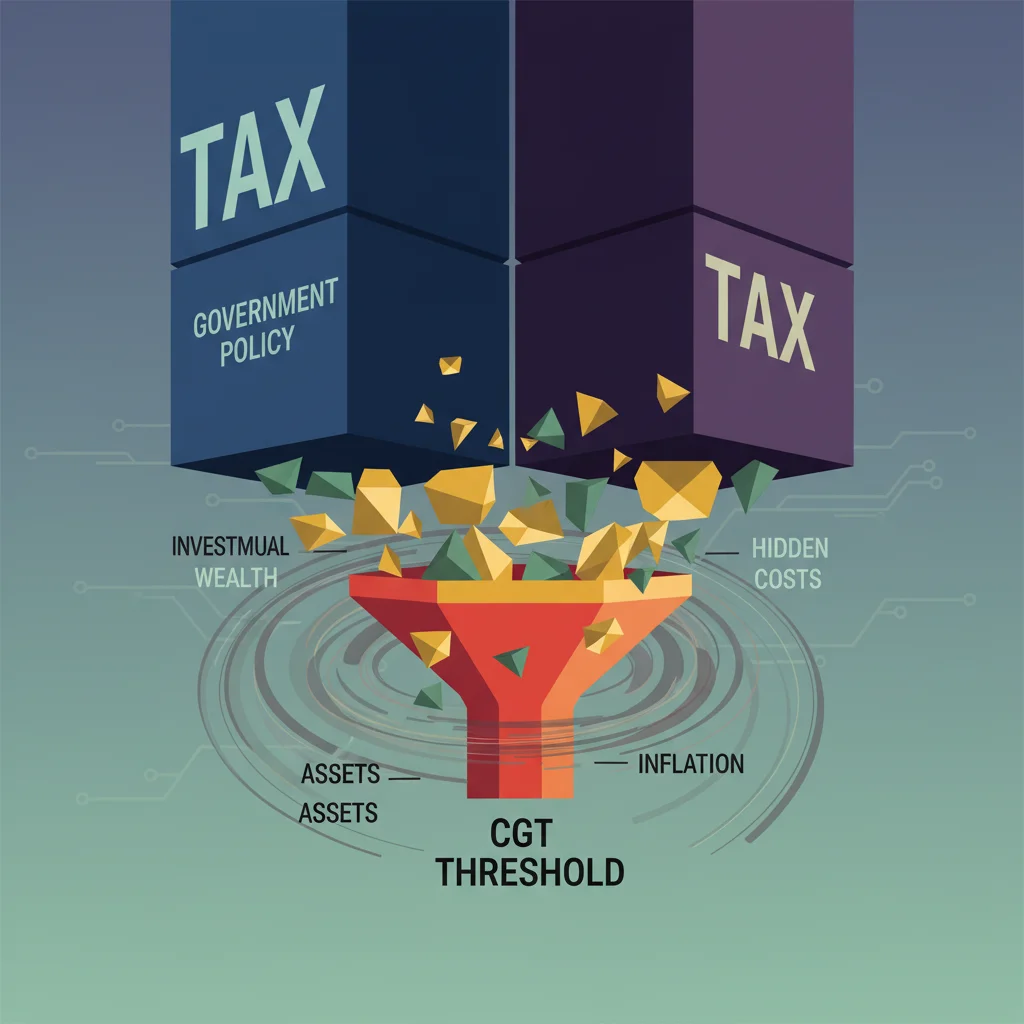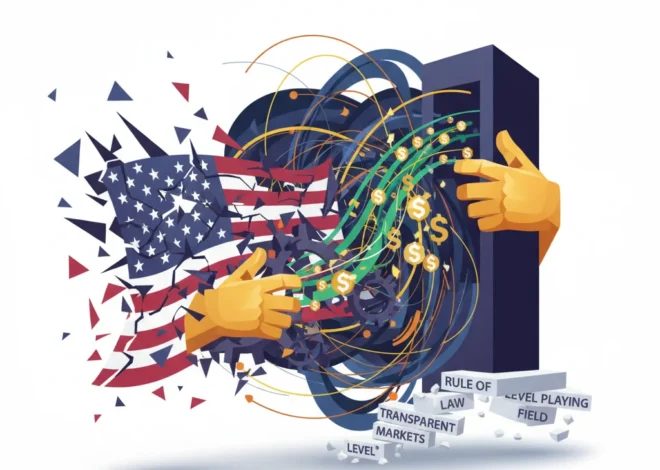
The Stealth Tax Squeeze: Why the UK’s Shrinking CGT Threshold is a Bigger Deal Than You Think
In the world of finance and investing, major announcements often grab the headlines. A 1% change in interest rates or a new budget policy can dominate the news cycle for days. But sometimes, the most significant shifts happen quietly, almost unnoticed, until they suddenly appear on a tax bill. This is precisely the case with the UK’s Capital Gains Tax (CGT) threshold—a change so subtle yet severe that one Financial Times reader recently described it as simply “derisory”.
While discussions about the broader economy often focus on income tax and corporation tax, the systematic dismantling of the CGT Annual Exempt Amount (AEA) represents a profound policy change. It’s a classic “stealth tax” that is poised to catch millions of unsuspecting investors, small business owners, and even “accidental” landlords in its net. This isn’t just a minor tweak for the ultra-wealthy; it’s a fundamental reshaping of the UK’s investment landscape that affects anyone with assets outside of a pension or ISA.
In this article, we will dissect this critical change. We’ll explore what the CGT threshold is, how drastically it has been cut, and who will feel the impact most acutely. More importantly, we’ll provide an expert perspective on the strategic moves you can make to navigate this new, more challenging tax environment and protect your hard-earned returns.
What is Capital Gains Tax? A Quick Refresher
Before diving into the changes, let’s establish the fundamentals. Capital Gains Tax (CGT) is a tax levied on the profit—or “gain”—you make when you sell (or ‘dispose of’) an asset that has increased in value. It’s the gain you’re taxed on, not the total amount of money you receive.
Assets that can be subject to CGT include:
- Shares and investments not held in an ISA or pension
- Second homes or buy-to-let properties
- Business assets
- Personal possessions worth over £6,000 (excluding your car)
- Cryptocurrencies and other digital assets
Crucially, every individual has an Annual Exempt Amount (AEA), which is a tax-free allowance for capital gains. For years, this allowance provided a significant buffer, allowing most small-scale investors to buy and sell assets on the stock market without ever worrying about a tax liability. It was this generous buffer that has now been all but eliminated.
The Great Squeeze: A Look at the Vanishing Tax-Free Allowance
The term “derisory” is strong, but when you look at the numbers, it’s hard to argue. The government has aggressively slashed the AEA in two successive tax years, fundamentally altering the calculus for UK investors. This move dramatically increases the number of people who will be liable for CGT, a fact confirmed by the government’s own projections which suggest the move will affect hundreds of thousands more taxpayers (source).
To illustrate the scale of this reduction, let’s compare the AEA over the last three tax years.
| Tax Year | Capital Gains Tax (CGT) Annual Exempt Amount (AEA) | Percentage Change from 2022/23 |
|---|---|---|
| 2022/23 | £12,300 | – |
| 2023/24 | £6,000 | -51.2% |
| 2024/25 | £3,000 | -75.6% |
As the table clearly shows, the tax-free allowance has been reduced by over 75% in just two years. A gain of £12,000 in the 2022/23 tax year would have resulted in a £0 tax bill. In the current 2024/25 tax year, that same gain would generate a taxable gain of £9,000, potentially leading to a tax bill of up to £1,800 for a higher-rate taxpayer selling shares, or £2,520 for residential property.
From Pop Icon to Portfolio Risk: The Unseen Economics of Brand Beckham
Who’s in the Firing Line? The Unexpected Victims of the CGT Squeeze
The common misconception is that CGT only affects City traders and property tycoons. The reality of the new £3,000 threshold is that it brings a whole new demographic of ordinary people into the tax net. Here are some of the groups who will be most affected:
- Small-Scale Stock Market Investors: Anyone using a General Investment Account (GIA) on popular trading platforms could easily breach the £3,000 limit with a single successful trade or by rebalancing their portfolio. What was once considered minor portfolio management now requires careful tax calculation.
- “Accidental” Landlords: Individuals who inherited a property or are selling a former home that was rented out for a period. A property owned for many years can easily accumulate a capital gain far exceeding the new threshold, leading to an unexpected tax liability.
- Crypto and Fintech Enthusiasts: The world of blockchain and digital assets is particularly vulnerable. Every time one cryptocurrency is traded for another, it counts as a disposal for CGT purposes. Active traders could rack up dozens of small gains that, when aggregated, far exceed the £3,000 allowance. This administrative burden alone is a significant hurdle.
- Employees with Share Schemes: Many employees, particularly in the tech and startup sectors, receive shares as part of their compensation. When they decide to sell these shares, they will now be far more likely to face a CGT bill on their profits.
The Office for Budget Responsibility (OBR) has estimated that the number of individuals and trusts paying CGT will more than double between 2022-23 and 2024-25, rising to over 600,000 (see page 110). This is a clear indicator of the policy’s wide-reaching impact on the UK’s personal finance landscape.
The Aadhaar Effect: Why the UK is Eyeing India's Digital ID to Revolutionize Its Financial Sector
Strategic Navigation: How to Mitigate the CGT Impact
While the new landscape is more challenging, it’s not unnavigable. Proactive and strategic planning is now essential for any serious investor. Here are five key strategies to consider:
1. Maximise Your Tax-Efficient Wrappers
This is the most crucial line of defense. Any investments held within an Individual Savings Account (ISA) or a Self-Invested Personal Pension (SIPP) are completely shielded from Capital Gains Tax. Before investing in a General Investment Account (GIA), ensure you have fully utilized your annual ISA allowance (£20,000 for 2024/25).
2. Utilise “Bed and ISA”
If you have investments in a GIA that have generated a gain, you can sell assets up to the value of your remaining AEA (£3,000) and then immediately use the proceeds to repurchase the same assets inside your ISA (subject to your available ISA allowance). This “Bed and ISA” maneuver crystallizes the gain tax-free and shields the asset from future CGT and income tax.
3. Leverage Spousal Transfers
Assets can be transferred between spouses or civil partners without triggering a CGT event. This is known as a ‘no gain, no loss’ transfer. This effectively allows a couple to combine their AEAs, giving them a joint tax-free allowance of £6,000 for the 2024/25 tax year. This can be a powerful tool for rebalancing a portfolio or selling a larger asset.
4. Embrace Tax-Loss Harvesting
Investing inevitably involves both winners and losers. Tax-loss harvesting is the practice of selling assets that are standing at a loss to crystallize that loss. These capital losses can then be used to offset any capital gains you have made in the same tax year. If you have more losses than gains, you can carry forward the unused losses indefinitely to offset gains in future years.
5. Time Your Disposals Carefully
With the AEA now so low, timing is everything. If you are planning to sell a significant asset that will generate a large gain, consider whether it’s possible to spread the disposal over two tax years. For example, selling a portion in late March and the remainder in early April could allow you to use two years’ worth of your annual allowance, doubling your tax-free gain from £3,000 to £6,000.
Conclusion: A New Era of Investor Responsibility
The “derisory” CGT threshold is more than just a gripe from a newspaper reader; it is a clear signal of a major shift in UK tax policy. It represents a subtle but powerful squeeze on investors, pushing more and more people into the complex world of self-assessment and tax liability. The era of casual investing without tax considerations is over.
The interplay between the tax system, new financial technology, and individual investment strategy has never been more critical. Understanding the rules of this new game is the first step. The second, and most important, is taking proactive steps to structure your finances in the most efficient way possible. By leveraging tax-efficient accounts, planning your disposals, and staying informed, you can ensure that this stealth tax squeeze doesn’t derail your long-term financial goals.


